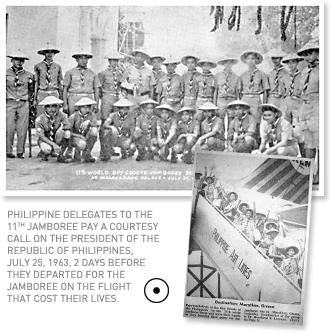
The Official Contingent of Philippines (the host country of the previous, 10th, World Scout Jamboree which took place in July 1959 in Makiling Park, Philippines) consisting of 21 Scouts and 3 Scouters, tragically perished in an airplane crash which took their lives together with all 55 passengers and 8 crew members aboard the de Havilland Comet 4C of United Arab Airlines (today Egypt Air) flight 869 from Tokyo to Athens via Hong Kong, Bangkok, Bombay, Bahrain and Cairo. The aircraft crashed into the Arabian Sea just off Bombay on 28 July 1963, 1:50am at night, while turning to prepare for landing at Bombay Santa Cruz Airport under severe turbulence and heavy rain. The bodies were never recovered. Read more about the tragedy
For the first few days at Marathon, the three flags outside the Jamboree General Headquarters -the World Scout flag, the flag of the Scouts of Greece and the Jamboree flag- in common with all national flags, flew at half-mast in memory of the Philippine contingent that was so cruelly struck by tragedy.
The camp site the contigent would have occupied, in sub-camp Aeantis, was kept empty as a sign of honour to the lost lives.
As documented in his unique testimony, Costas Veloudakis, a member of the Greek Organizing Committee, had to drive to Marathon from Athens that day to convey the bad news in person to J. Plaridel A. Silvestre, the vice president of the Boy Scouts of Phillipines and Chief of the Philippino Contingent at the Jamboree and his colleagues Godofredo Neric, Miguel Gatuslao and Judge Vicente F. Delfin, who were already at the Jamboree as members of the International Staff with the special role of representing the host country of the previous Jamboree. Veloudakis had to drive to Marathon to convey the bad news himself because, at the time, telephone lines were still being tested.
The sentimental burden was enormous when, during the opening ceremony, on the evening of August 1st, after all previous Jamboree kylixes where lit, J.P.A. Silvestre lit the kylix of the 1959 Jamboree and then handed the torch to Crown Prince Constantine, Chief Scout of Greece, to light the central Kylix of Friendship of Marathon.
Everyone was astonished with the scouting spirit of the Philippines when, within few days from the opening, three Philippine Scouts, Assistant Scoutmaster Nicasio Fernandez Jr. and Scouts Louis P. Santiago and Guillermo Flores, arrived at Marathon to participate in the Jamboree as a token delegation. The three delegates were initially intended to have travelled with the rest of the contingent on July 28th, but due to a complication which costed time, they did not make the originally planned trip. In a sign of mourning, the three scouts wore black armbands during the whole duration of the Jamboree.
On their first morning in camp, the token delegates and J.P.A. Silvestre were welcomed for breakfast by Camp Chief, Dimitris "Rann" Alexatos and Organizing Commissioner Colonel J. Wilson.
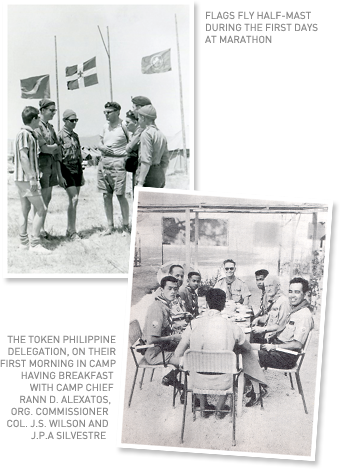
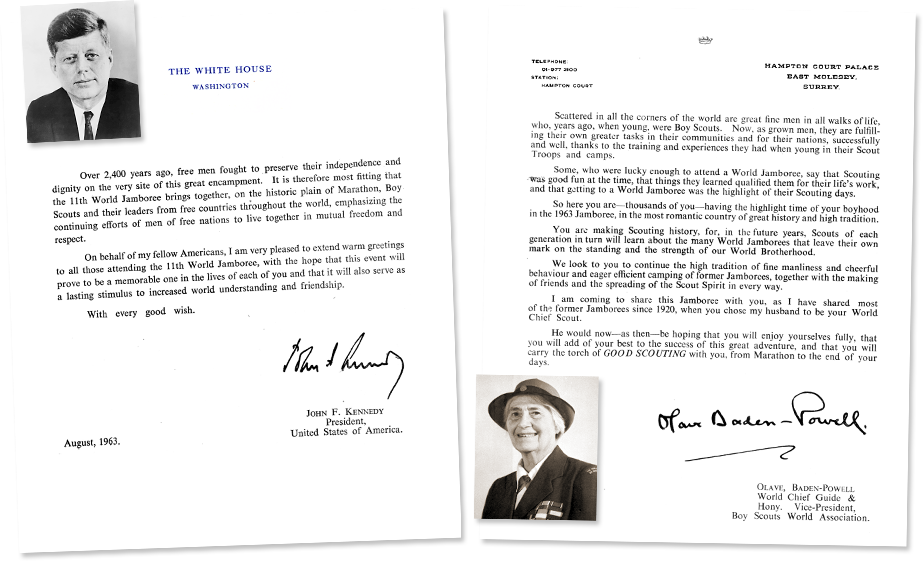

Milk for the entire Jamboree was provided free, as a gift from the people of the United States. Total quantity amounted to some 216,000 quarts. Provision of this pure whole milk was made possible by the combined cooperation of the Greek Government, the Jamboree Organising Committee, the U.S. Air Force, the Ex-Cello-O Corporation of Detroit, the Foremost Dairies Inc. of San Francisco, and the United States Department of Agriculture.
U.S. Secretary of Agriculture Mr. Orville L. Freeman, in announcing the program, said: “This is an excellent illustration of just one of the many ways in which the abundance of our farms can be – and is being – used, not only to improve world health and nutrition, but also to achieve meritorious international goals of human betterment such as those for which the Boy Scouts are striving”.
The Department of Agriculture provided about 150,000 pounds of non fat dry milk and 35,000 pounds of butterfat, which was flown to the Athens plant of the Foremost Dairies, which runs a plant under contract to the U.S. Air Force station at Ellinikon, Athens. It was recombined into whole milk in the refrigerated factory there.
The 216,000 quart cartons to contain the milk had been contributed by the Ex-Cello-O Corporation of Detroit, Michigan thanks to the support of the company's president, H. Glenn Gixby. Transportation daily to the Jamboree site in Marathon was handled by the refrigerated trucks of the U.S. Air Force. A refrigerated capacity was established at the Jamboree site to store the milk and from this direct distribution was made to the participants.
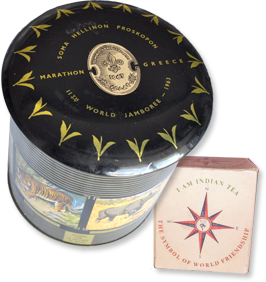
A beautiful 9 colour caddy (with a capacity of 650 grams of tea) illustrating the series of six birds-animals, each representing a commercially well-known tea district in India, with the Jamboree Crest inscribed on the lid and the 1959 West Bengal Jamboree Song at the bottom was fabricated for the 11th World Scout Jamboree by the Indian Tea Board. The Greek Shipping Lines (Hellenic Lines) at the request of the Greek Boy Scouts Association carried the entire consignment free of charges from Calcutta to Piraeus Port. The total weight of the tea was about 4500 lbs. or 2000 kilograms packed in 3800 caddies. To ensure delivery in time, the tea left Calcutta Port on the 10th of May 1963.
Jamini Sarkar, the Board’s Welfare Liaison Officer, who was one of the Headquarter Commissioners of the Bharat Scouts & Guides, a former King’s Scout and Instructor to the Indian Contingent to the 5th World Jamboree of 1937 in The Netherlands, represented the Board at the Jamboree and reported for duty to the Greek Boy Scouts Association at Athens on the 22nd July 1963. As no Scout Contingent from India could attend the Jamboree, J. Sarkar was the only one to represent the Indian Scouts at the Jamboree. On arrival at Marathon, the Organisers of the Jamboree appointed J. Sarkar as the Commandant of the International Emergency Service Troop for handling the various emergency works with the aid of over 350 Scouts/Guides from 24 countries.
The tea caddies were issued to participants on a patrol basis along with food rations. Every patrol received two such caddies filled with delicious Indian tea. On appropriate occasions the Board’s representative presented the special Jamboree Caddies in caskets to the King and Queen of the Hellenes, the Crown Prince Constantine, Chief Scout of Greece, Princess Irene, Olave Lady Baden Powell, the Ambassadors and Consuls of different countries and the world Press who visited the Jamboree. The caddies were so appreciated that there were innumerable requests from the participants and visitors even for the empty caddies.
Tea Board of India organised three contests for Jamboree participants through the Daily "Marathon Courier" - "Indian Tea - The Symbol of World Friendship Contest" column and prizes were distributed to the winners by Mrs. D. Alexatos, the wife of the Camp Chief.
On 8th of August 1963, on the occasion of the visit of J.N. Khosla, Ambassador of India, Madame Khosla along with Mr. L.E. Vafiadis, Honorary Consultant for India in Greece, to the Jamboree, Contingent Leaders, Camp Officials, the Mayor of Athens and Army Officials were invited at the Jamboree Pavilion in the Jamboree where J.N. Khosla presented tea caddies to the distinguished guests.
There was universal appreciation for Indian Tea at the Jamboree. At the end of the Jamboree, the caddies were raffled between the boys of the patrols. Even the empty tea caddies were taken by the different contingents back to their countries as the best souvenir of the 11th World Jamboree. In fact, almost half of the tea caddies were taken back unopened by several contingents as they wanted to celebrate a special day of Indian Tea with their own Scout troop on their return to home. However there were only 3,800 caddies and 14,000 scouts and only a select few enjoyed taking back home a tea caddy as one of the most beautiful souvenirs of the Jamboree.

One of the most fascinating moments of the Closing Ceremony was when the Crown Prince announced that the host country of the 12th (next) World Jamboree would be the United States and a 16-year old USA Eagle Scout Dean Lycas, of Indiana, with two escorts, advanced to the Crown Prince to receive the lighted kylix (torch) of the Marathon Jamboree, to be rekindled at the opening of the 12th Jamboree, in 1967 in his country. As Dean narrates in his personal diary, which he kindly shares on marathon1963.com, he then presented the torch to the leaders at the American Headquarters. The torch was to be placed in the Boy Scout Museum at New Brunswick, N.Y.
Dean was with Jamboree Troop 17 of the Transatlantic Council, which brought Scouting to American boys of military, diplomatic and other families stationed in the European and Mediterranean area. Dean's father, Lt. Col. John Lycas, was then with Headquarters, 24th Infantry Division at Augsburg, Germany. Both his parents are of Greek origin.
The two Scouts who flanked Scout Lycas as honour guard were Scout Tucker Lee Melancon, 17 of Shirley Rd., Bunkie, Louisiana, with Jamboree Troop 16 and Eagle Scout Ernest W. Armstrong, (Jr.) 17 of Washington D.C., a member of Jamboree Troop 17.
Major General D. C. Spry, Director of the Boy Scouts World Bureau at the time, while commenting on the selection of United States as host to the 1967 World Jamboree, said:
"It will be extremely popular with boys. I know from personal experience what magnificent hosts the United States can be. There will be all the facilities and attractions boys look for when they sweat and strain to earn the money to go. It will make it easier for boys from yet another part of the world to attend a World Jamboree. We expect a tremendous attendance from Latin America and the Carribean and there’s already great interest in Europe. Most important, with the movement crowing everywhere, it will be a great focal point for the ideals and purposes of the World Brotherhood of Scouting."

During the Jamboree, 8 special meetings and reunions took place at Marathon. On the second day of the Jamboree, on the afternoon of Friday, August 2nd the Reunion of Past Jamborees Delegates took place. On the third day of the Jamboree, Saturday August 3rd, there were two special meetings: The Philatelists's Meeting in the morning and the YMCA in the afternoon.
The prestigious World Conclave for King, Queen, Eagle and Crown Scouts participating at the 11th Jamboree was held at 11 o'clock in the morning of the 6th day, Tuesday August 6th at the Reunion Place in the pinewood. The particular Conclave for owners of the highest rank of their countries' scout programmes was actually the second to even take place; the first having been organized during the 10th World Scout Jamboree at Makiling Park, Philippines in July 1959. The 2nd King-Queen-Eagle-Crown Scouts World Conclave of Marathon was also bound to be the last; the event was never held again. Participants to the World Conclave received a dedicated white felt badge printed with Greece's King's Scout emblem in the middle on green background, circumscribed by the words "KING QUEEN EAGLE CROWN MARATHON 1963" on yellow background.
The World Scout Committe met twice during the Marathon Jamboree, on the mornings of the 8th and 9th days, Thursday and Friday August 8th and 9th. On the afternoon of August 8th another prestigious meeting took place: the Wood Badge Holders reunion; participants also received a dedicated badge, showing a WB necklace around a training axe on olive green background. The words "REUNION ΜΑΡΑΘΩΝ 1963" were printed in the middle. A last special meeting took place on the afternoon of the 9th day at camp, Friday August 9th, it was the International Training Team Reunion.
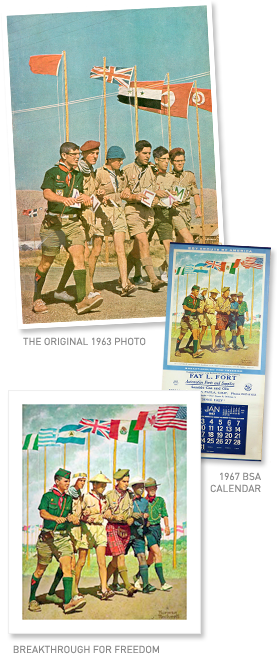
By 1967, 54 years had passed since Norman Rockwell (1894 – 1978), one of America's most popular painters and illustrators, famous for the cover illustrations of everyday life scenarios he created for The Saturday Evening Post magazine for more than four decades, had joined the national staff of the Boy Scouts of America as the sole artist for Boy's Life, the monthly magazine of the BSA. Since 1925, Rockwell had also been illustrating the annual cardboard-mounted wall calendars of the BSA, a task he assumed for 52 years, until 1976.
In 1967, the Unites States were to host the 12th World Scout Jamboree in Farragut State Park, Idaho. Rockwell was asked to create a painting for the 1967 annual BSA calendar that would commemorate the great event. He created "Breakthrough for Freedom", a painting showing a group of scouts marching while holding arms together.
The illustration is actually inspired by a photograph taken at the 1963 World Jamboree in Marathon; the photo shows a group of scouts marching into one of the arena shows as part of the Wide Game that aimed to get scouts acquainted with each other. Each scout had a placard with a letter, and had to find another 10 scouts with the right placards and align in a manner that the word "NENIKHKAMEN" is spelled, then march into the arena in a group.
The original photo was actually on the cover of the December 1963 issue of Boy's Life while the 1967 painting by Norman Rockwell never actually made it on the magazine's cover.
Rockwell's interventions on the original photo are interesting. It appears that the only character left practically unchanged is the first from left, a BSA Explorer wearing khaki shorts, forest green shirt and socks, a white web belt and red sock tabs, all standard BSA issue. Even his photo camera and the Jamboree brass emblem above his right pocket are reproduced in the painting.
Rockwell's Scout calendar paintings of the late sixties and early seventies reflected preoccupations such as friendship among the youth of the world and Scouts of all races having fun together in their patrols and troops. In Breakthrough for Freedom, Rockwell kept the structure and movement of the group but replaced every figure, except from the BSA Explorer -to whom he added a standard issue Garrison hat- with international scouts from the five continents in recognizable national uniforms: He added an Arab, a Filipino, a Scottish and an African Scout to represent all races.
His intervention on the flags is also obvious. He added the greek flag at the originally empty mast and replaced the Iraqi, Tunisian, Turkish and the Jamboree's orange flag with the flags of USA, Canada, Mexico and Nicaragua. The latter country was not represented in the 11th Jamboree at Marathon.
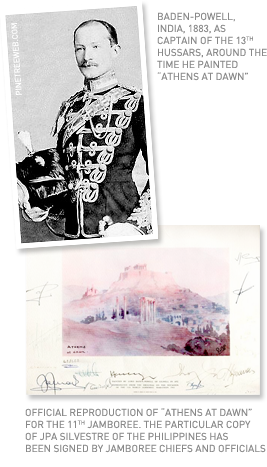
It was as early as his school days, back in the 1870s, that young student Robert Stephenson Smyth Baden-Powell, later founder of the Scout Movement, discovered an affection -and a talent- for drawing and painting.
After finishing school in 1876 he had to make a career decision. His main idea being that he would like to travel, he sat for an examination to join the army. He passed so high up on the list that he received a commission straight away as a Sub-Lieutenant in the 13th Hussars cavalry regiment. As the regiment was then stationed in India, he immediately got his desire to travel. He sailed from Portsmouth on the 30th October, 1876, and landed at Bombay on the 6th December. With the exception of a two-year sick leave, 1878-1880 when he was sent home, he stayed in India until 1884 when the regiment moved to South Africa where trouble between the Boers and the British was brewing. It was where the foundations of the World Scout movement were to be laid.
It was sometime between 1876 and 1883 (ages 19-26)* on one of his trips between UK and India that Baden Powell visited Athens and was inspired to create a work entitled "Athens at Dawn", an aquarelle of the Acropolis of Athens and surrounding area.
The original aquarelle was handed by Lady Olave Baden Powell to the General Chief of the Scouts of Greece, Dimitris "Rann" Alexatos in London in 1960, on the occassion of the announcement of Greece as the host country of the 11th World Scout Jamboree. In 1963, a high-quality silk-print was reproduced from the original and was given as a gift to select guests and officials at the Jamboree. A very special painting for Greece by the founder of the Scout movement from his very early, pre-scouting days.
Alexatos later donated the aquarelle to the Scouts of Greece; it is since kept in the historical archive and awaits for its place in the Museum of Greek Scouting.
* The exact date of this painting is uncertain. The Hellenic Posts that circulated the painting on one of the commemorative stamps of the 11th Jamboree series, claim it was made in 1882. On the silk-print reproduction on the occasion of the 11th Jamboree it is written that the painting is from 1872. Alexatos in his book claims that Olave gave him this painting that was made in 1876. scoutsrecords.org claims it was made in 1883. No explicit reference of BP visiting Athens Greece at the time, was found in the literature.
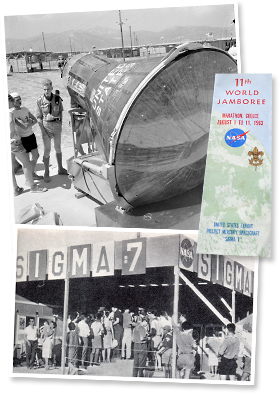
Probably the most attractive display at the National Exhibitions site was the United States exhibit, the actual Project Mercury Spacecraft or "Sigma 7" capsule in which Eagle Scout Wally Schirra orbited the earth six times on October 3rd, 1962. It was the fifth United States manned space mission, part of NASA's Mercury program. The nine-hour flight was the longest U.S. manned orbital flight yet achieved in the Space Race until that date.
The American National Aeronautics and Space Administration (NASA) had cooperated with the Greek Armed Forces to make display of the spacecraft possible at the Marathon Jamboree. A dedicated hangar was built and there were always long queues of people interested to see the spacecraft from close.
The Scouts found that the movements in flight were under control of the astronaut. In the 3-meters (9-feet) long spacecraft, with room for one, were 7 miles of electric wire required for instruments, breathing devices, temperature control, communication, retro rocket detonators and safety devices.
To return to earth, the astronaut had to fire three retro rockets to slow down the craft. As it plunged down through the earth's atmosphere, the spacecraft glowed red with heat from friction, but the astronaut was protected by a special insulating shield.
The last 3 kilometers (10,000 feet) of the return to earth was by parachute. A rescue helicopter hovered near the spot where the spacecraft would land in the ocean. The astronaut was lifted to a waiting aircraft carrier, marking the successful completion of another exciting chapter in the history of space exploration.
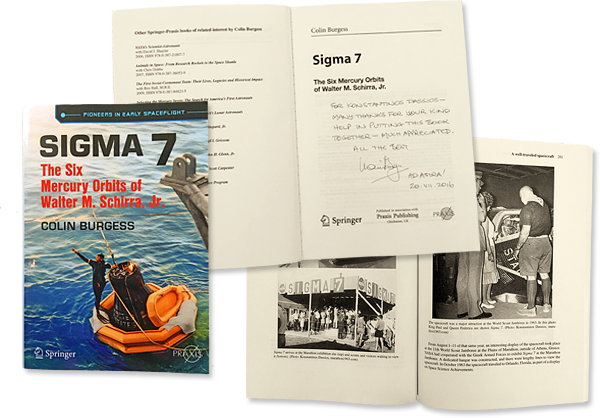 In June 2016, the book "Sigma 7: The Six Mercury Orbits of Walter M. Schirra, Jr." by Colin Burgess was released by Springer International Publishing Group. The book offers a comprehensive look at the 1962 orbital mission of Wally Schirra aboard the spacecraft which was later the US exhibit in the National Exhibitions event in Marathon, as described in the previous paragraph. It is the first book about this popular pioneering astronaut.
In June 2016, the book "Sigma 7: The Six Mercury Orbits of Walter M. Schirra, Jr." by Colin Burgess was released by Springer International Publishing Group. The book offers a comprehensive look at the 1962 orbital mission of Wally Schirra aboard the spacecraft which was later the US exhibit in the National Exhibitions event in Marathon, as described in the previous paragraph. It is the first book about this popular pioneering astronaut.
During his research, Colin contacted marathon1963.com in search of material covering the showcase of Sigma 7 at the 11th World Scout Jamboree. We were happy to provide him with photographs and informative material which he included in his book and he was kind enough to send us a autographed copy of the book with dedication. Much appreciated.

The Conference Venue was the Grand Hotel, right at the heart of the City of Rhodes, 500 meters from the picturesque Old Town part of Rhodos, just by the sea.
Delegates arrived and registered for the Conference on Monday, August 12th. On the same day, the Chairman of the Conference, C. Roy Nichols, also Chairman of the Far Esat Committee, laid a wreath on the Cenotaph of Rhodes. On the evening, the Nomarch of Dodecanese gave a Buffet Dinner at this residence for Crown Prince Constantine, President d'Honneur of the Conference, for the World Commmittee and the authoritites of Rhodes.
The Conference opened on August 13th with a BP prayer and a welcome message by CP Constantine. On that morning there were discussions on the reports of the World Committee & Bureau and of the Finance Sub-Committee. The evening session dealt with the first theme of the Conference, synopsised in the eternal question: "Is scouting up to date?"
On Wednesday, August 14th, delegates were preoccupied with two other subjects: "Citizenship Training" and "The role of the professional Scouter". Reports by the Arab, Far East and World Training Committees were also discussed. In the evening three study groups were formed to further elaborate on the three themes. CP Constantine received holders of the Bronze Wolf while the day closed with a camp fire at the Municipal Garden where new Bronze Wolves and gifts were presented.
Thurday, August 15th was a relaxed day. In the morning there was an excursion and in the evening folklore shows at the National Theatre given by the Municipal Ballet. At 21:00 the mayor of Rhodes welcomed delegates to a buffet diner at the Municipal Gardens.
Friday, August 16th was consumed around the fourth and fifth themes of the Conference: "The Cub Programme" and "Boy Scout Unit Standards". The reports of the European Executive Committee, of the Inter-American Scout Advisory Committee and of the Committee on Scouting with the Handicapped were also presented. The day closed with a presentation on the World Friendship Day by D. Makrides, previously the Deputy Camp Chief of the 11th World Scout Jamboree and a buffet diner by the management of the Grand Hotel.
The sixth theme of the Conference, "The Older Age Programme" was discussed on the morning of Saturday, August 17th along with Rover/Explorer issues (reports from the Rover Study Committee, the USA National Explorer Conference, Rover activies and Rover Congress) and coming events (20th World Conference, 1965 and 12th World Jamboree, 1967). At noon, the elections for the World Committee members took place. The new World Committee met in the afternoon and sat at a dinner the same night.
On the last day of the Conference, Sunday, August 18th there was "Te Deum", an Eastern Orthodox service at the Cathedral with optional attendance and reports by the various study groups and the Resolutions Committee. The Closing Ceremony took place at 18.30 and ended with the renewal of the Scout Promise. A farewell dinner was given by Soma Hellinon Proskopon (Scouts of Greece) on the last evening.

Although Ukrainian Scouting (Plast National Scout Organization of Ukraine, founded 1911) was banned in 1922 when the country came under the Soviet Union's communist regime and became one of the constituent republics of the Union of Soviet Socialist Republics (U.S.S.R.), the organization continued to exist in exile around the world. And despite not documented in the official participants list of the 11th Jamboree in Marathon, 35 Ukrainian boy scouts in exile participated in the great event.
In the August 24th, 1963 sheet of the Ukrainian Weekly newspaper, we read that the all-Ukrainian delegation included a United States delegation of 11 boy scouts, 8 girl scouts and 3 Senior Scout Leaders, namely Dr. Athanas Figol, Rev. Bohdan Smyk, Senior Scout from Utica, New York, and Senior Scout Dr. V. Pomirko of Chicago, Illinois.
The American-Ukrainian contingent arrived in two groups; the first led by Senior Scout Dr. Athanas Figol arrived at Marathon on July 26, 1963 while the other, under Rev. B. Smyk, came from Italy two days later. After their arrival the Ukrainian Boy Scouts paid an official visit to the principal headquarters of the Greek Scouts where they presented greetings from Ukrainian Scouting. Senior Scout Mykola Svitukha was also present in the visit, as the official representative of the Ukrainian Boy Scout organization.
The Ukrainian delegation was numerically the largest among all other Scout-in-Exile organizations of the Jamboree, and nineteenth among the 89 participating delegations from various countries of the World.
Of interest are the Ukrainian Scout stamps issued for the Jamboree by The Supreme Command of Ukrainian Scouting. Bearing the traditional Ukrainian Scouting emblems, the stamps were taken by the Ukrainian Scouts to Marathon. The stamp design was drawn by artist M. Levytaky and was printed with the financial support of Harry Poworoznyk, president of Essex Packard, Ltd. and veteran Ukrainian-Canadian leader. A special postmark cancellation seal consisting of the Plast logo inside the Jamboree's boeatian shield characteristic sign, is also stamped on all Ukraine-related philatelic memorabilia from the Jamboree as seen in the graphic.
For the record, the names of the eleven Ukrainian Boy Scouts and Girl Guides who participated in the Jamboree were:
O. Lysiak and I. Berezhnytsky from Philadelphia, Pa.;
А. Вilуk. R. Volianaky, Y. Povkh and B. Pryimak from Rochester, N.Y.,
Y. Hrusbkevych from Cleveland, Ohio;
M. Vintonіv from Boston, Mass.;
Z. Tsybyk from Newark, N.J.;
O. Baransky from Yonkers, N.Y.; and
I. Yurthuk from Amsterdam, N.Y.
Girl Guides
H. Korenets, member of the Supreme Scout Command,
I. Stoikevych, Νational Commandant of Girl Scouts in the United States,
H. Khamula, O. Pahasiuk, Z. Bobynsky, M. Milanych, H. Kachmarsky and L. Masiuk.
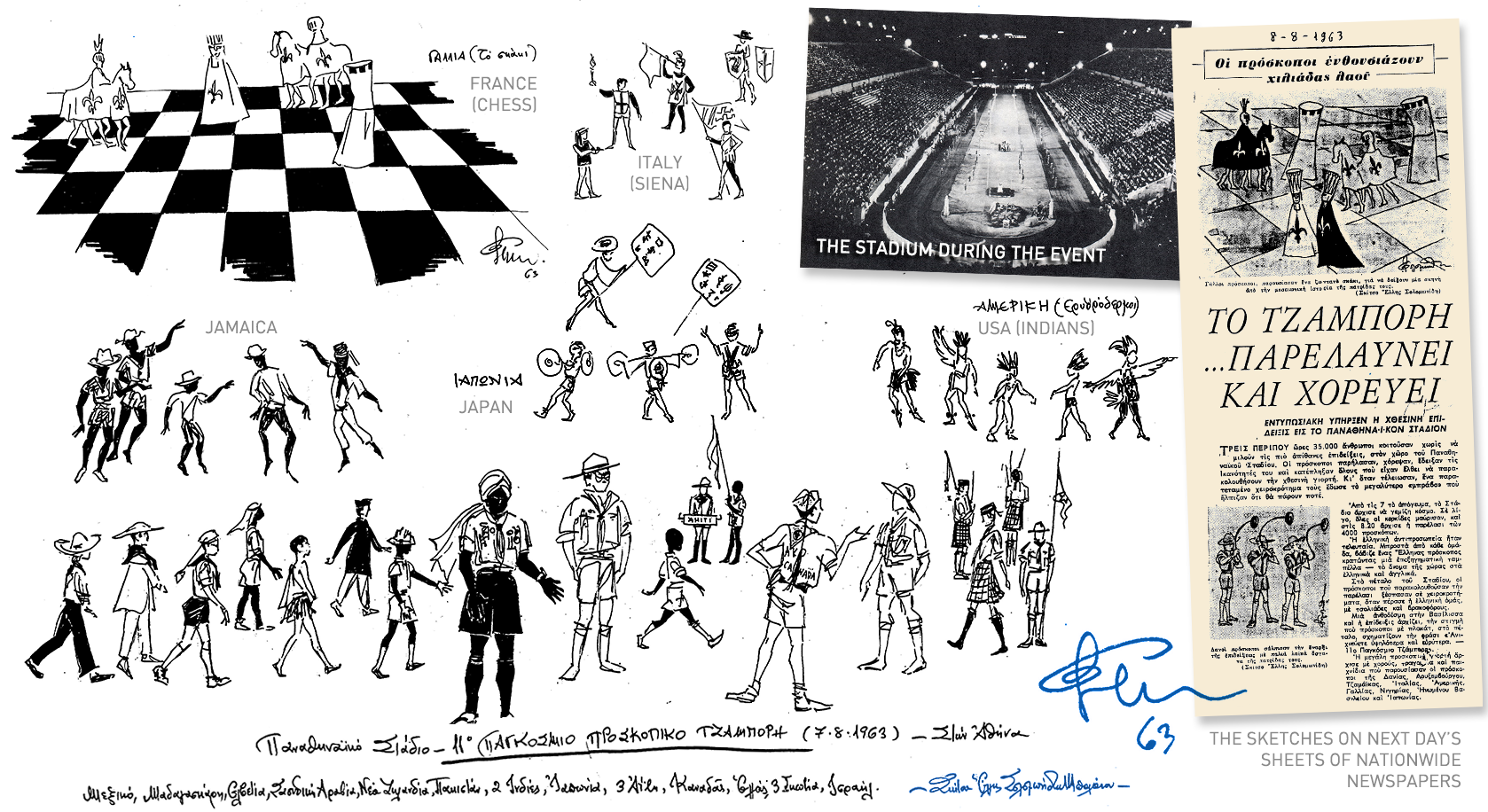
Mrs. Solomonidou-Balanou, studied painting, costume design and scenography at the Athens School of Fine Arts and the Doxiadis School, under such teachers as Yannis Moralis, Yannis Tsarouchis, Spyros Vassiliou and Tassos. She continued her studies in Art History at the Universita per Stragnieri, Perugia, Italy with a scholarship from the Italian Institute of Athens. She worked as a music producer at the Greek National Radio Foundation (NRF) while often editing music for theatrical radio-broadcasts. In 1961, she started capturing the artistic events of Athens with sketches for the theatrical, musical and dance critic columns of major newspapers "Kathimerini", "Mesimvrini" and the magazine "Eikones", published by Helen Vlachos.
In 1965, she was the first set designer and costume designer in the Theater Department of the -then newly founded- Hellenic Broadcasting Corporation (ERT). She often collaborated as a set and costume designer with the National Opera, and as a music curator with the National Theater and other Athenian theaters.
At a time when photographs of nocturnal events were impossible to make the next day's newspaper, Mrs. Solomonidou unique ability to outline sketches in the dim light and under time pressure, and send it immediately to the newspaper, left a mark. It was her set and costume design background that gave her the impressive ability to render costumes, sets and atmosphere, so elegantly.
Part of the thousands of sketches in her 50 year professional archive has been published in two albums: “30 years of sketches, Theater-Music-Dance” (1988). “Sketches of Elli Solomonidi Balanou, 1987-2007” (2008)
In a twist of plot, Mrs. Solomonidou is a former Chief of the Girl Guides of the Psychiko suburb of Athens, while the publisher of her two aforementioned albums, Mrs. Lucy Bratsiotis, is the daughter of late Professor Nikolaos Bratsiotis, former National Commissioner of the Scouts of Greece.
Let Mrs. Solomonidou's sketches travel us back to the summer night of August 7th, 1963, in the historic Panathenian Stadium in downtown Athens, home of the first modern Olympic Games in 1896, when 2300 scouts from all the countries of the Jamboree put on a display, for the World.
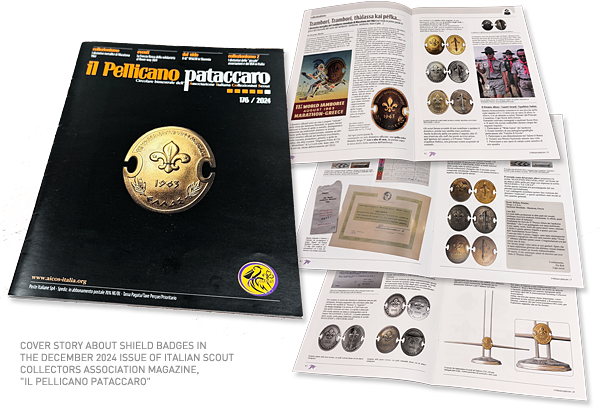 In December 2024, the magazine of The Italian Scout Collectors Association (AICoS), "il Pellicano pataccaro" published a cover story on the shield badges of the 11th World Scout Jamboree, which were the first ever jamboree badges to be constructed of metal (as opposed to the fabric badges of the first 10 world scout jamborees).
In December 2024, the magazine of The Italian Scout Collectors Association (AICoS), "il Pellicano pataccaro" published a cover story on the shield badges of the 11th World Scout Jamboree, which were the first ever jamboree badges to be constructed of metal (as opposed to the fabric badges of the first 10 world scout jamborees).
In 6 pages, author Giacomo Marini presents the results of his research mainly on the variants of the badges (bronze, silver and the exquisite gold one) but also on other items of collector interest such as the Laurel Award and the "holy grail" of Marathon Jamboree memorabilia, the tabletop gate statuette.
The article merges all current knowledge on the topic, from the most important collectors and connoisseurs, and undoubtedly represents the definitive guide to Marathon shield badges. A truly magnificently piece of work.
marathon1963.com is proud to have assisted Giacomo's research with information and photos which appear in the article. We thank him for his kindness to send us a hard copy of the very elegant and luxuriously printed magazine.
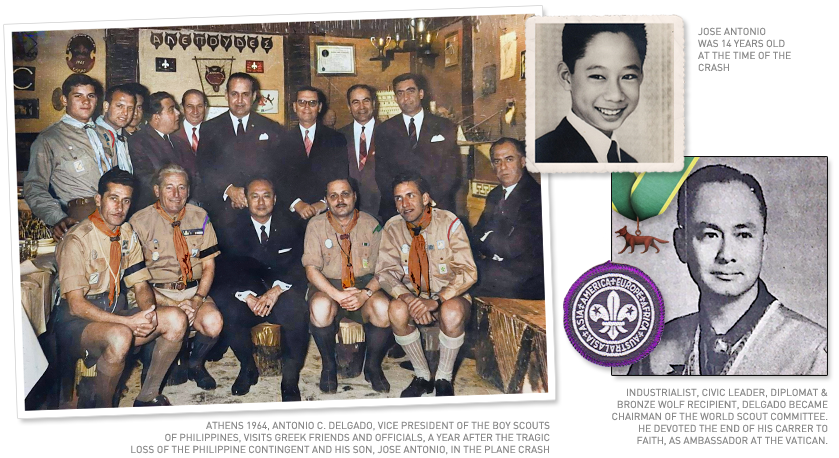
Delgado's visit wasn't etiquette; it was rather pilgrimage. Tragicaly, the vice president's own son, Jose Antonio Chuidian Delgado, was among the 24 boy scouts that has perished in the crash. In an even more tragic irony of fate, although Delgado had planned for the whole family to accompany Jose Antonio to Marathon after the end of a family vacation abroad, the 14 year old insisted on departing earlier, to join his friends in the Filipino contingent, on time1.
The body of Jose Antonio Chuidian Delgado was one of the five that were positively identified from among the human remains recovered in the Bay of Bombay2. During the state memorial service that took place weeks after the crash, Delgado spoke on behalf of all parents of fallen Scouts3:
For this is the other side of the coin of grief: The glory. The honor. The triumph...
In the forefront of these boy's minds, the noble ideals of the Scout Oath were always held as shining goals: 'Honor... Duty... God... Country.'
These boys kept their Honor; and they kept their Faith; and they gave their all for their Country...
And I am sure they kept themselves in the friendship of God.
A unique memento of Delgado's visit in Athens, a commemorative photographic record of the Vice President and greek hosts posing at the premises of the 36th Scout Group of Kolonos, Athens, also headquarters of the Local Scout District of Kolonos, was courteously provided to marathon1963.com by 11th WSJ scouter Yiannis Kavvadias, who was present that day, as Deputy Chief of the 4th Scout Troop of Athens and whom we gratefully acknowledge.
Τhe snapshot shows A.C. Delgado seated (middle, in suit) in front of 11 WSJ Camp Chief and emblematic longtime National Commissioner of the Scouts of Greece, Bronze Wolf recipient Dimitris "Rann" Alexatos. Kavvadias (seated, second from right) was well acquainted with Filipino officials from the Marathon days, as the Antiochis subcamp in which he belonged, was headed by J. Plaridel A. Silvestre, then Vice President and Deputy National Scout Commissioner of the Boy Scouts of the Philippines, who was part of the 7-person delegation that had arrived at Marathon early, as members of the International Staff.
Seated in the photograph are, left to right: Head of the 35th Scout Group of Athens Panagiotis Tsanos (uniformed), Local Scout Commissioner of the District of Kolonos Panos Petropoulos (uniformed), Antonio C. Delgado, an unidentified uniformed scouter, Kavvadias (uniformed) and another unidentified individual. Standing, left to right, are: Deputy Chief of the 37th Scout Troup of Athens Anastasios Mexis, Head of the 37th Scout Group of Athens Athanasios Nikitakis, Scouter in the 37th Scout Group of Athens Androutsopoulos, Head of the 24th Airscout Group of Athens Stylianos Kouletakis, Scouter in the 15th Scout Group of Athens Konstantinos Avgoustinos, Rann Alexatos, 11th WSJ Organising Commissioner Nestor C. Constantoulis, Scouter Karras and an unidentified individual. All seated uniformed scouters around Delgado are wearing the official 11 WSJ staff neckerchief (in orange color with laurel print), which confirms their active involvement in the Jamboree. Three scouters, Tsanos, Petropoulos and Karras are wearing black armbands, which most probably highlights the time of visit, after the death of King Paul of Greece, in March 1964.
In their son's memory, Antonio C. Delgado and his wife established the Jose Antonio Delgado Memorial Fund (JADMF), mostly known as the Ala-Ala Foundation, which is still active today in assisting socio-economically disadvantaged Filipino Youth. One of the Foundation's first acts was the erection, in 1964, of the Ala-Ala Memorial Mausoleum, in Manila's North Cemetery, in memory of the perished boy scouts.
In a lifetime of grief for the loss of his beloved child, Delgado achieved to levels beyond exceptionally. Founder of ten companies, among which Delgado Brothers, Inc., the largest fully integrated transportation company in the Philippines, he was elected President of the Philippine Chamber of Industries in the 1960s. In the 22nd World Scout Conference in Otaniemi, Finland, 1969, Delgado became the first Asian to be elected Chairman of the World Scout Committee. In the 1971 World Scout Conference in Tokyo, Japan, he was awarded the World Organization of the Scout Movement's highest award, the Bronze Wolf. In 1975, Delgado eventually followed his faith and was appointed Ambassador of the Philippines to the Vatican, a seat he maintained through 1982. There, with the help of Pope John Paul II, he searched for a possible first Filipino Saint. Delgado returned to the Creator piecefully in 1992, at age 75, in his home in Metropolitan Manila, leaving his legacy of positive impact, values, faith and influence on others, for the world to ponder and inspire upon. His professional work is continued by his son Jose Eduardo Delgado, President and CEO of Delgado Brothers Inc and of the Jose Antonio Delgado Memorial Fund.
1 Official facebook page of the Boy Scouts of the Philippines, post of 15 July, 2025 "We Remember Jose Antonio Delgado"
2 Philippine Normal University Library facebook page, post of 28 July 2025
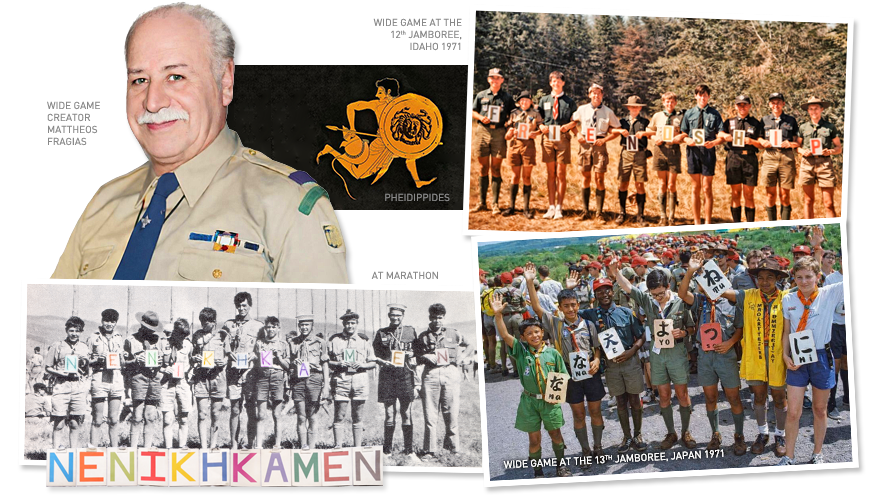
The concept was ingenious in many ways. Not only the game served the purpose of warming relations in the camp by quickly locating and acquainting with other scouts from every country, but did it with special symbolism as well (everything appeared to hide a symbolism, back in the day). Not only was the greek word, written in letters which are common to the latin alphabet, recognizable and pronounceable by anyone, but its 11 characters fitted perfectly the main theme of "11" of the 11th Jamboree. It was ingenious also because the word was historically linked to the campsite, one of Greece's most symbolic landmarks, the plain of Marathon, which the country offered to host the event. NENIKHKAMEN were the actual last words of ancient Greek soldier-messenger Pheidippides, who ran in full armour, in September 490 BC, all the way from Marathon to Athens, to convey to his fellow Athenians the news of victory against the Persians, at the battle of Marathon. He had hardly whispered "NENIKHKAMEN" when he fell dead from exhaustion. Pheidippides was the first marathon runner in history; in his honor the Marathon race was instituted at the first modern Olympic Games, in Athens in 1896, a distance of 42.195 km. The Marathon race has since been an emblematic olympic and world sports event. The symbolism of the messenger was key in the 11th Jamboree, with the depiction of the ancient greek running courier behind a running boy scout being the main theme of the Jamboree poster, newspaper, philatelic first day covers, souvenirs, etc.
On the morning of Saturday August 3rd, 1963, third day into the Jamboree, each scout was provided with a paper card, which randomly carried one of the letters N, E, I, K, H, A or M, each printed in different color. The goal was that 11 newly-found friends of 11 different nationalities, had to join and line up, holding their cards at chest level, in the right order so that the 11-letter ancient Greek word NENIKHKAMEN would form. Participation in the Wide Game qualified towards the Laurel Award (Epathlon Dafnis). All Scouts took part in what went down in history as the perfect start that brought scouts from all over the world, closer, fostering international brotherhood through shared challenges, cultural exchange, and lasting connections.
The Jamboree-wide game noted such success that was played in the 12th World Scout Jamboree, Farragut State Park, Idaho 1967 and in the 13th World Scout Jamboree, Mount Fuji, Japan 1971. In the primer event, 10 scouts joined and lined up to form the word "Friendship", while in Japan, 7 lined-up placards were needed to form the word そなえよつねに (Sonaeyo Tsuneni, japanese for Be Prepared, the scout motto), while successful completion earned them a unique neckerchief slide.
The person who conceived the idea of the game was Mattheos Fragias, then District Commissioner of the East Attica District of the Scouts of Greece. In Greek scouting, Fragias reached the role of Assistant National Commissioner of the Scouts of Greece and was awarded the national organization's highest medal, the Silver Phoenix in 1989. In professional life, he was Director of the Bank of Greece. He may not be among us anymore, but world scouting has his ingenious conception of a unique Wide game, to ponder upon. That's the legacy of NENIKHKAMEN, from a time that everything carried a special symbolism and a deeper meaning.


© Copyright 2013, marathon1963.com & proskopos.com. All rights reserved.
No part of the material contained in this website (images, texts, artwork) may be used or reproduced without
written permission or invitation by the publisher. Request permission to use or reproduce material.